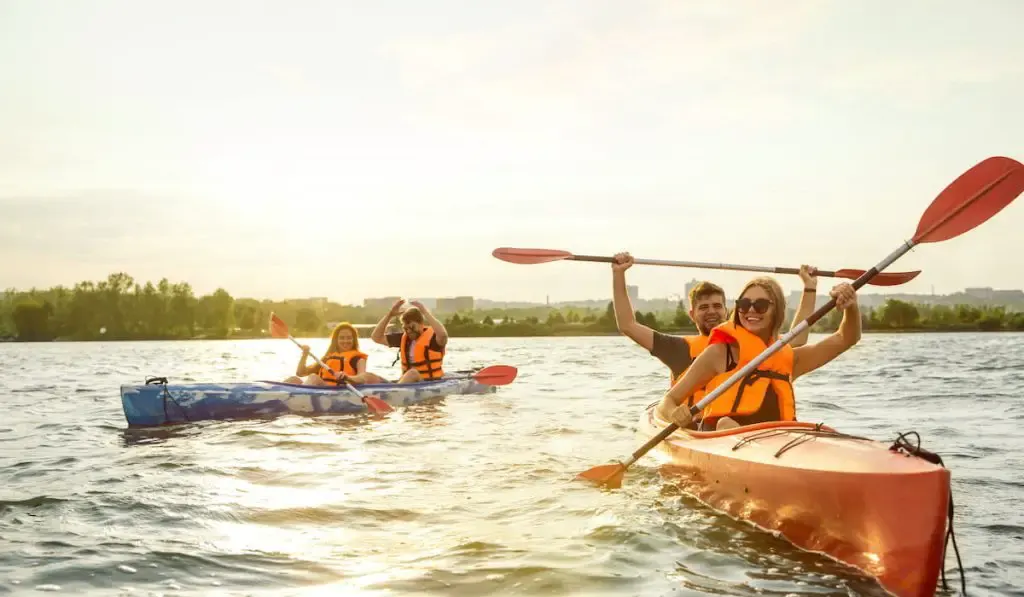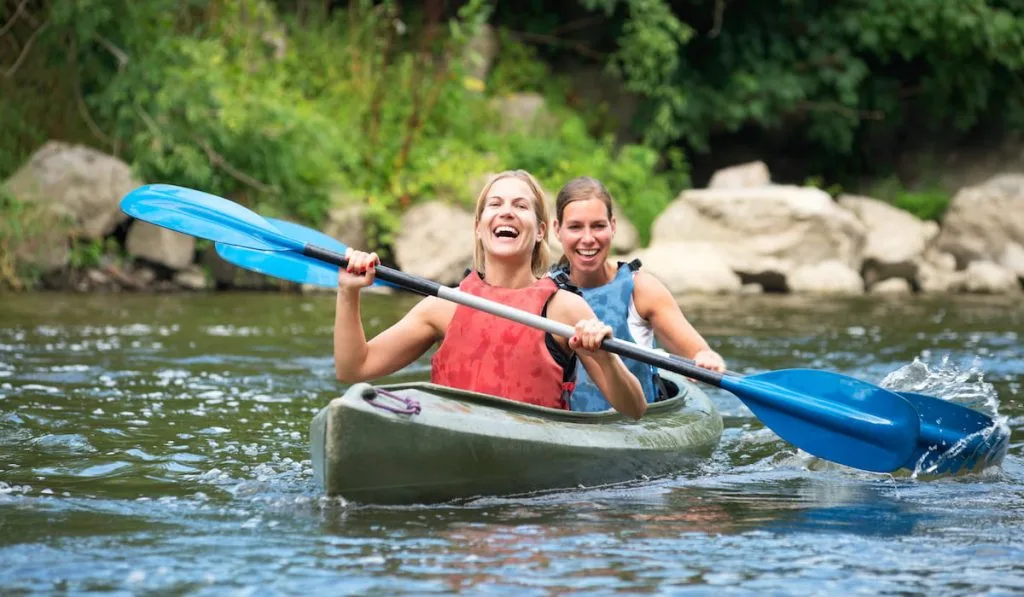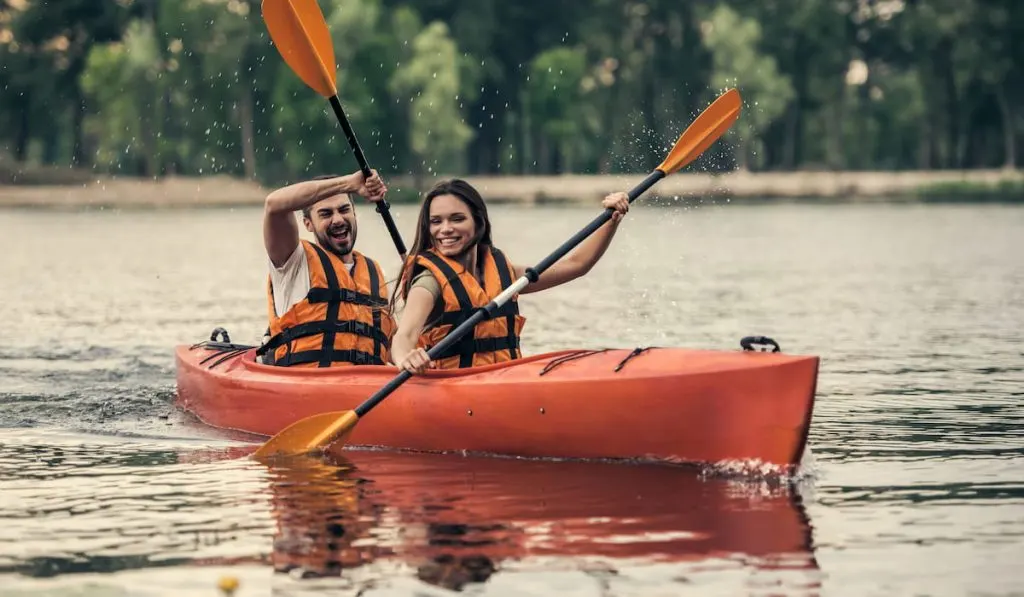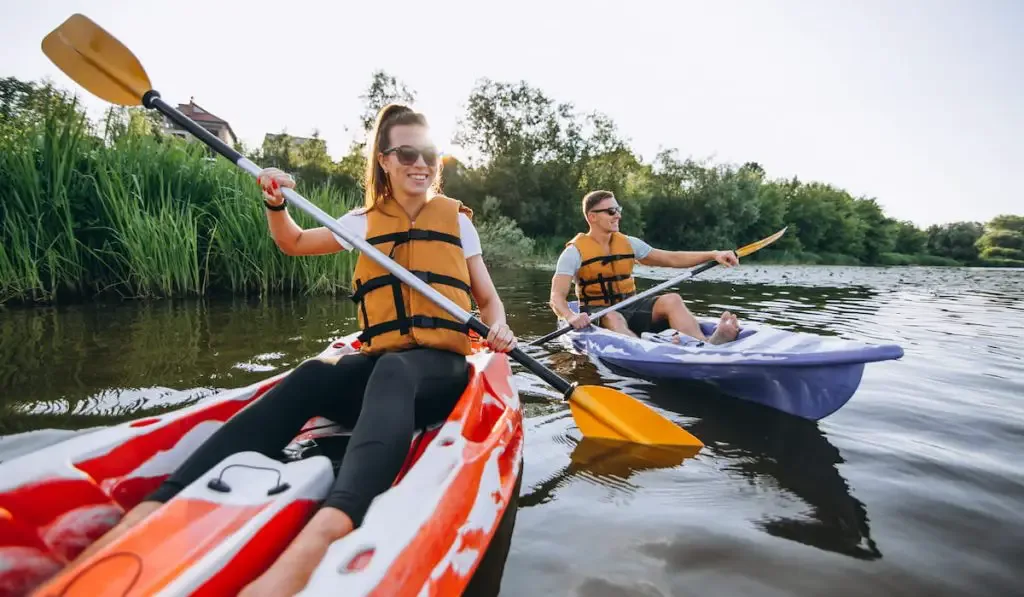Kayaking can be a fantastic adventure for nature lovers, however, not everyone is experienced in the sport. Kayaking is not an innate skill, therefore everyone who kayaks was at some point inexperienced.
Can you kayak without experience?
You can kayak without experience if you are well prepared, truly understand the complexities of the sport, and find a kayaker with some experience to help you out the first time. Sure, kayaking may appear easy, however, staying safe while kayaking does require some knowledge and preparation.

Kayaking without experience is not something to fear, in fact, it is awesome that you want learn how to kayak. There are some things you need to know, however, in order to kayak safely without experience.
How Can You Kayak Without Experience?
You can kayak without experience if you learn about the sport of kayaking beforehand and are well prepared. Having at least a somewhat experienced kayaker teach you the ropes is vital to the whole process.
Kayaking alone is never recommended and whoever you go with should have some kind of experience with kayaking. They do not have to be professionals, but it helps if they can give you tips and help you when needed.
Kayaking without experience is much easier if you have all of your accessories with you and practice getting in and out of your kayak. Getting into and out of a kayak is probably the most difficult part of kayaking.
What Do You Need To Know Before Kayaking Without Experience?
Before you go kayaking without experience, you need to know several things including how to paddle properly and how to steer the kayak.
It is also important to know the type of water you will be in and what the weather forecast for the day is.
Type Of Water
Stick with calm waters and away from rushing rivers until you are well experienced in kayaking. Beginners should start in small ponds and lakes to learn the basics before trying something more difficult.
Whitewater rivers and other waterways with fast-moving currents are too dangerous for beginners and not recommended. The more experience that you gain, the more you can branch out to rougher waters.
Weather
Always check the weather for your area before embarking on your first kayaking experience. Steer clear of heavy rain, bad weather, and extremely windy conditions. These can all make kayaking more dangerous.
Getting In And Out
You should also understand the difficulty in getting in and out of a kayak, especially one that you sit inside of.
If you are getting into the kayak from a dock, it is easier to sit down on the dock with the kayak parallel to you.
It is important to practice getting in and out of a kayak in the water, with and without the use of a dock. To stay safe when kayaking, especially without experience, you have to know how to get back into the kayak if you accidentally come out of it.
Paddling and Steering a Kayak
Understanding how to properly use a paddle and steer a kayak is very important. Sitting in the kayak, you will hold the middle shaft of the paddle with both hands, a little wider than the width of your shoulders.
With the scooped part of the paddle looking towards you, place one side of the paddle into the water, pushing backward to begin moving forward. Continue paddling, switching sides repeatedly, to move straight forward.
The trick is to use your whole body, especially your core muscles when paddling. It should be a comfortable repetitive motion that does not tire you out quickly.
Learning to steer will come with practice, but paddling long strokes on just one side will turn you in the opposite direction. Stroking the paddle in reverse will help you stop or go backward when needed.

Tips For Kayaking Without Experience
- Find someone who has some experience in kayaking to at least teach you how to steer properly.
- Make sure you know how to get in and out of the kayak, with the use of a dock and in open water.
- Wear a life jacket at all times, even if you think you will be fine without one or it is not a law to have one.
- Learn how to paddle properly to steer the kayak in the direction you need to go.
- Keep a whistle or foghorn on the kayak within reach to call for help.
Where Can You Find a Kayak Guide?
Kayak guides can be found online or at local water sports centers. Many water-based tourist centers and locations offer kayak guides to teach newcomers how to kayak.
Kayak guides will teach you the basics of kayaking as well as how to follow a river and avoid dangerous currents. They will teach kayakers without experience how to stay safe in their kayak and on the water.
Where Can You Practice Kayaking Without Experience?
The best places to practice kayaking without experience are small lakes or calm parts of larger lakes. The calm water will allow you to learn how to paddle with ease without getting swept away.
You should always kayak with someone with at least some experience kayaking, so ask them what nearby location is best for learning.
The goal when kayaking without experience is to be safely out of the way of fast-moving boats. It is also important to steer clear of fast-moving river currents, both of which can spell danger for kayakers, especially beginners.

What Supplies Do You Need To Kayak?
The first part of kayaking without any experience is getting the right supplies and equipment. Being prepared is a vital part of the whole kayaking experience.
Here are the most important things you will need for your first time kayaking.
Kayak
Choosing the right kayak is an adventure in itself. There are different kinds of kayaks that are made for a variety of skill levels and intended purposes.
Recreational kayaks are the best for beginners who just want to kayak on calm waters. Sit-on kayaks are great for fishing because they allow for more movement.
Touring kayaks and whitewater kayaks are ideal for those who want to either travel long distances in the water or actually kayak in rivers and more advanced waterways.
Paddle
A paddle is the second most important accessory when kayaking, after the kayak itself, of course. You cannot just go picking any paddle either, there is a science to picking the right one for your height.
For kayaks that range between 24 and 28 inches, if you stand less than 65 inches tall, the right paddle for you will probably be 87 inches. If you are taller than that, 90 inches will work best.
Most sports stores will say to stand beside the paddle with it upright and reach that hand up to the top. If you cannot reach the top, it is too tall; if you can curl your fingers over the top, and it reaches past your palm, then it is probably the perfect size.
Life Vest
Life vests are personal flotation devices made to keep you afloat in the water. Life vests, or life jackets, are extremely important for all kayakers, no matter how much you may not want to use one.
Many public lakes and waterways require them, so it is really not something you can do without. Choose a life vest that feels comfortable and allows you to move as freely as possible.
Whistle Or Noise Device
Many public water areas require kayakers to keep a noise device of some kind on their kayak or person at all times. This can be a whistle, foghorn, or other approved noise device.
These noise devices allow kayaks to alert others of their presence or their need for help. Check your local outdoor guidelines to learn what is required for your area.
Anchor
Anchors are not required, but they allow kayakers to anchor themselves to a specific area in the water for an extended amount of time. This is ideal for kayakers who are fishing, but also very useful for any kayaker.
Kayak anchors are small, weighing only about 3.5 pounds, and can fit easily on the kayak. Without an anchor, you will continue to drift even when you stop paddling.
Waterproof Box
Waterproof boxes, containers, or bags are very necessary for kayakers to keep their personal things safe from water. Keys, phones, and more can be placed in them and they will not get wet.

Things to Keep in Mind
- You can kayak without experience, however, no one should ever kayak alone. To stay safe, you might as well find an experienced kayaker to go with you.
- Kayaking in an ocean is very dangerous and only recommended for extremely experienced kayakers.
- Always watch the weather when kayaking, especially without experience. Choppy currents are very difficult to manage in a kayak.
- Do not be afraid to ask a kayak guide for help. They are trained to help inexperienced kayakers.
- Find a quiet, local lake or pond to practice in to get your bearings. You can test out your paddle and kayak setup to make sure you have all the accessories that you need.
Final Thoughts
You can kayak without experience if you take a few precautionary measures first.
Ask an experienced kayaker for help, be prepared, and do your homework. The more you know and understand about kayaking, the better prepared you will be to kayak without experience.
Resources
Learning about how you can kayak without experience was an exciting adventure in itself. Here are the sources used to write this article.
